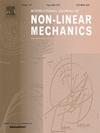中型车辆变速箱 "嘎嘎 "声的稳健控制
IF 2.8
3区 工程技术
Q2 MECHANICS
International Journal of Non-Linear Mechanics
Pub Date : 2024-09-30
DOI:10.1016/j.ijnonlinmec.2024.104915
引用次数: 0
摘要
扭转振荡可对自动变速器构成重大挑战,包括换挡过程中离合器系统摩擦引起的不稳定性。例如颤振、尖叫、抖动、抖动和尖叫。变速器异响不仅仅是一种恼人的噪音,它还是潜在问题的症状,如果不加以解决,可能会导致严重的结构性故障。尖叫是一种高频扭转振荡,主要是由于负摩擦斜率和变速器系统中存在弱阻尼振荡模式而引起的。虽然有许多被动方法可以防止汽车变速器离合器的异响,但被动方法的主要缺点是有效时间有限。本文特别关注使用主动控制技术来缓解 "唧唧 "声。由于异响发生在离合器输出端,因此使用输出速度作为测量信号,离合器夹紧力作为控制动作。主要目标是开发一种控制策略,既能有效抑制 "唧唧 "振动,又能最大限度地减少控制工作,而这是以往自动变速器摩擦诱发振动(FIV)稳健控制研究中忽略的一个重要方面。所设计控制器的有效性在经过实验验证的 9 速自动变速器非线性车辆级仿真模型上进行了测试。使用所设计的控制器,成功地抑制了嘎嘎声振荡。通过与工业常规 PI 控制器的比较,证明了 μ 最佳控制器在最小控制力度和更平稳的离合器接合方面的性能。本文章由计算机程序翻译,如有差异,请以英文原文为准。
On robust control of transmission squawk in a medium-duty vehicle
Torsional oscillations can pose a significant challenge in automatic transmissions, including those stemming from instabilities induced by friction in the clutch system during shifts. Examples include chatter, squeal, shudder, judder and squawk. Transmission squawk is more than just an annoying noise; it is a symptom of underlying issues that, if left unaddressed, can lead to significant structural failures. Squawk is a high-frequency torsional oscillation, predominantly induced due to a negative friction slope and the presence of a weakly damped oscillating mode in the transmission system. Although numerous passive methods are available to prevent the squawking of the clutch in automotive transmission, the significant drawback of passive methods is the limited duration of effectiveness. This paper particularly focuses on the mitigation of squawk using active control techniques. Since squawk occurs in clutch output, therefore, the output speed is used as the measured signal and clutch clamping force as the control action. The primary objective is to develop a control strategy that effectively dampens squawk oscillations while also minimizing control effort, a crucial aspect that has been overlooked in previous research on robust control of friction-induced vibrations (FIV) in context of automatic transmissions. The effectiveness of the designed controller is tested on an experimentally validated non-linear vehicle-level simulation model of a 9-speed automatic transmission. With the designed controller, the squawk oscillations are successfully suppressed. Comparisons with industrial routine PI controller are made to demonstrate the performance of -optimal controller in terms of minimal control effort and smoother clutch engagement.
求助全文
通过发布文献求助,成功后即可免费获取论文全文。
去求助
来源期刊
CiteScore
5.50
自引率
9.40%
发文量
192
审稿时长
67 days
期刊介绍:
The International Journal of Non-Linear Mechanics provides a specific medium for dissemination of high-quality research results in the various areas of theoretical, applied, and experimental mechanics of solids, fluids, structures, and systems where the phenomena are inherently non-linear.
The journal brings together original results in non-linear problems in elasticity, plasticity, dynamics, vibrations, wave-propagation, rheology, fluid-structure interaction systems, stability, biomechanics, micro- and nano-structures, materials, metamaterials, and in other diverse areas.
Papers may be analytical, computational or experimental in nature. Treatments of non-linear differential equations wherein solutions and properties of solutions are emphasized but physical aspects are not adequately relevant, will not be considered for possible publication. Both deterministic and stochastic approaches are fostered. Contributions pertaining to both established and emerging fields are encouraged.

 求助内容:
求助内容: 应助结果提醒方式:
应助结果提醒方式:


